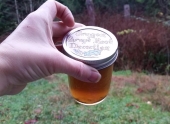

 1
1





"Never doubt that a small group of thoughtful, committed citizens can change the world; indeed, it's the only thing that ever has."-Margaret Mead "The only thing worse than being blind, is having sight but no vision."-Helen Keller


















Do you think that the people can't taste it, or that they can't appreciate it?Apparently, different individuals differ in their ability to taste the ginseng like essential oils in the bud, which are probably nerolidol or cerdol.
"Never doubt that a small group of thoughtful, committed citizens can change the world; indeed, it's the only thing that ever has."-Margaret Mead "The only thing worse than being blind, is having sight but no vision."-Helen Keller




 ) It sounds like the taste experience for you is even more intense and sophisticated. I would have not given this much though, if Verna Pratt, who is something of a legend in our little corner of world noted this as well.
) It sounds like the taste experience for you is even more intense and sophisticated. I would have not given this much though, if Verna Pratt, who is something of a legend in our little corner of world noted this as well.














"Never doubt that a small group of thoughtful, committed citizens can change the world; indeed, it's the only thing that ever has."-Margaret Mead "The only thing worse than being blind, is having sight but no vision."-Helen Keller














"Never doubt that a small group of thoughtful, committed citizens can change the world; indeed, it's the only thing that ever has."-Margaret Mead "The only thing worse than being blind, is having sight but no vision."-Helen Keller




Christine Wilcox wrote:He perceives the devil’s club shoots as a mild spring green but nothing special















I have peeled the outer layer of the tips to expose just the soft inner morsel. Usually spiny layers can be removed easily from my experience.I think they were getting a little too big and the spines were starting to form, as they were really crunchy.
"Never doubt that a small group of thoughtful, committed citizens can change the world; indeed, it's the only thing that ever has."-Margaret Mead "The only thing worse than being blind, is having sight but no vision."-Helen Keller




Roberto pokachinni wrote:I have peeled the outer layer of the tips to expose just the soft inner morsel. Usually spiny layers can be removed easily from my experience.

|
life is short - but not as short as this ad:
turnkey permaculture paradise for zero monies
https://permies.com/t/267198/turnkey-permaculture-paradise-monies
|





